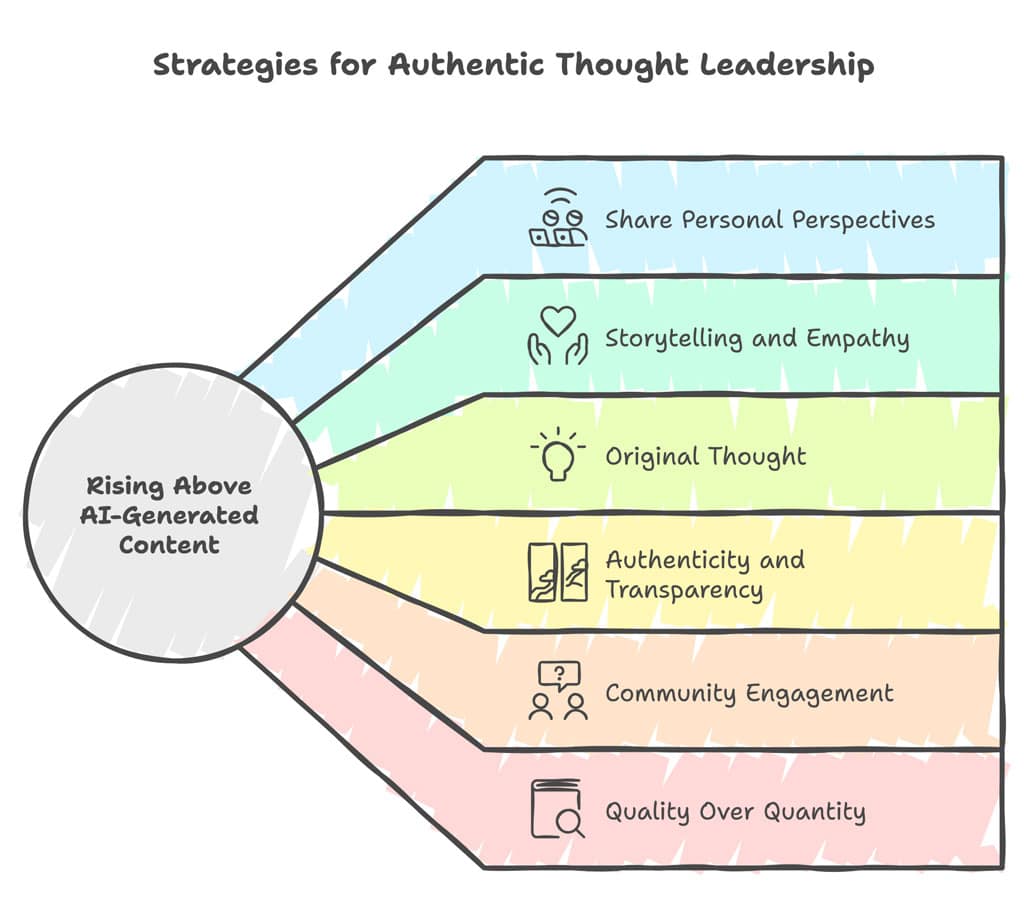5 Ways AI Is Killing Thought Leadership—and What You Can Do to Fight Back

Not long ago, if you published regularly and demonstrated a knack for sharing valuable insights, people automatically viewed you as a content powerhouse—a genuine thought leader. I know this firsthand: I once wrote 2,000 blogs in 2,000 days, earning a reputation as a “content machine.” That commitment to consistent, valuable writing eventually led to my being selected as one of the Top 20 Leadership Experts in the World, and it opened doors for me to regularly contribute to major publications like Inc, Entrepreneur, and Business Insider, among many others. Back then, that kind of output was both rare and impressive.
These days, anyone with a computer and an AI text generator can achieve that same volume of polished material in a fraction of the time, raising the question of whether AI has effectively killed thought leadership. In many ways, AI has flooded the market with endless blog posts, LinkedIn articles, and automated videos.
But there’s a crucial area it can never replace: your personal experience. AI might simulate expertise by scouring the internet for facts, yet it can’t replicate the human element—the way you handled a complex situation, the emotional rollercoaster you felt at the time, and the real, on-the-ground lessons you learned.
In a world where everyone else is zigging—using AI to crank out more of the same—true thought leaders need to zag by offering fresh angles and challenging norms. Thought leadership isn’t about applying a better polish; it’s about introducing new perspectives, pushing boundaries, and focusing on the experiences that shape us all. While AI can churn out an ocean of content, it isn’t going to share the mental and emotional facets that make human stories so compelling.
Here are five ways AI is contributing to the decline of what we used to think of as thought leadership—and what genuine leaders can do to stand out:

1. Overabundance of Content
What’s happening:
AI has dramatically lowered the barriers to producing written, audio, or video content. Tools can churn out polished pieces at breakneck speed, far faster than any human writer ever could. This results in a tidal wave of articles and social posts that all jostle for attention.
Why it matters:
When everyone is flooding the market with constant updates, volume alone no longer signals expertise. Audiences are overwhelmed, making it harder for truly insightful content to stand out. This shift necessitates a focus on quality over quantity—delivering fewer, but more impactful, pieces that resonate deeply with your audience.
2. Lowered Barriers to Entry
What’s happening:
Thanks to the widespread availability of AI writing apps and other automation tools, it’s never been easier to publish something that appears authoritative. Even with limited real-world know-how, someone can crank out professional-looking blogs or social content.
Why it matters:
This “democratization” of content creation leads to a flood of new voices—many of whom are “Thought Leaders Lite,” armed with surface-level knowledge but lacking true depth. Meanwhile, real experts struggle to stand out amid the noise. To counter this, true thought leaders must leverage their deep expertise and unique experiences to provide value that AI-generated content simply cannot match.
3. Homogenization of Voice & Insight
What’s happening:
Most AI systems work by blending existing data and ideas. While they can produce structured copy, the output often sounds formulaic. Novelty and uniqueness get sacrificed for efficiency.
Why it matters:
When everyone’s pulling from the same digital knowledge base, you end up with a sea of interchangeable content—and it becomes difficult for genuine thought leaders to stand out. To combat this, focus on delivering original insights and perspectives that are rooted in your unique experiences and expertise. This differentiation is what makes your voice truly memorable and authoritative.
4. Erosion of Trust & Authenticity
What’s happening:
Audiences can’t always tell who wrote a piece: a person with firsthand experience or an algorithm rearranging internet knowledge. This ambiguity can undermine trust.
Why it matters:
Thought leadership has always relied on credibility and genuine expertise. If people suspect you’re publishing AI-driven filler without real personal insights, it casts doubt on your authenticity and authority. Maintaining transparency and authenticity is crucial—share your personal stories, admit your knowledge gaps, and be honest about how you use AI as a tool rather than a crutch.
5. “Thought Leadership Lite”: The Rise of Curators & Polishers
What’s happening:
There’s a new wave of individuals who excel at curating or polishing AI content, giving it a slick presentation, and calling themselves experts. They quickly assemble top-ten lists, apply trendy buzzwords, and dazzle the casual observer with shiny packaging.
Why it matters:
This brand of quick-fix “content guru” can overshadow genuine thinkers who put in the time for research, reflection, and experimentation. Over time, this erosion of distinction between true insight and superficial repackaging undermines the entire ecosystem of thought leadership. To stand apart, focus on creating original content that offers new perspectives or deep dives into topics that matter, rather than merely repackaging existing information.
What This Means for Thought Leadership
We’re no longer just drowning in a sea of content; we’re swimming among countless “instant experts”—people who can churn out impressive-looking work at a moment’s notice, yet often lack the hard-earned, experiential knowledge that genuine leaders possess.
Thought leadership isn’t just about displaying “expertise” in a vacuum. It’s about sharing your lived experiences—the emotional highs and lows, the gray areas, the real lessons gleaned from on-the-ground situations that AI can’t replicate. It’s these stories and candid insights that foster trust and differentiate you from the pack.
It can be easy to become complacent, or even lazy, and just go with the flow by leveraging AI to generate content when you’re not in the mood. I know I have done that too, but it’s not thought leadership—it’s akin to thought leadership suicide by AI. Real thought leaders have to fight back and not just sink under this sea of fortune-cookie-like wisdom.
Moreover, when everyone else is zigging—using AI to produce more of the same—no one is truly thinking creatively or critically. When we all think the same, then no one is really thinking. This homogenization stifles innovation and reduces the diversity of ideas that are essential for meaningful progress. True thought leaders must strive to zag—to think differently, challenge conventional norms, and introduce fresh perspectives that push the conversation forward.
Additionally, the pervasive use of AI can lead to a lack of genuine engagement. AI-generated content often lacks the depth and emotional resonance that comes from personal experience and authentic storytelling. Without these elements, content becomes just another drop in the ocean, failing to make a lasting impact or inspire real change.
How True Thought Leaders Can Fight Back

Despite the challenges, there are strategic ways to rise above the sea of AI-generated noise. Here’s what you can do:
1. Share Your Depth of Perspective & Experience
- Lean on Real Stories: AI can supply information, but you can describe the exact emotional rollercoaster you rode when a business deal fell through or when you successfully launched a new initiative.
- Offer the ‘Why’ Behind the ‘What’: Bring in the messy, human side of how you arrived at your conclusions. Did you face dissent? Did you pivot midway? The nuanced layers are what make your voice memorable.
2. Increase Resonance Through Storytelling & Empathy
- Narrate Personal Journeys: Audiences connect deeply with how you felt, the dilemmas you faced, and the lessons you learned. AI lacks that emotional nuance and lived reality.
- Highlight Universal Struggles: Show that you’re wrestling with the same challenges your audience faces. Authentic empathy for their situation builds trust that no AI can mimic.
3. Deliver (Truly) Original Thought
- Challenge the Status Quo: Offer new viewpoints or innovative ideas instead of just rehashing what’s out there. Thought leadership requires a certain boldness that AI, by its nature, can’t organically provide.
- Conduct Your Own Experiments: Run small tests, interview unique voices, or investigate overlooked angles. Adding new data or fresh angles to the conversation is the essence of leading thought.
4. Double Down on Authenticity & Transparency
- Show Your Process: Feel free to mention how you use AI as a supporting tool, but be clear that it doesn’t replace your personal experiences or in-depth research.
- Own Your Knowledge Gaps: People respect a leader who admits they don’t have all the answers but are willing to learn and adapt.
5. Foster Community & Engage with Your Audience
- Dialogue Over Monologue: Invite feedback, host Q&As, and encourage debates. Real leadership blossoms in interactive, two-way conversations.
- Curate With Context: If you do leverage AI content or data, add a layer of interpretation based on your own background. Offer a viewpoint only you could provide, grounded in real-world application.
- Leverage Diverse Media: Utilize different media formats—videos, podcasts, interactive webinars—to engage your audience in varied and dynamic ways. This not only makes your content more accessible but also caters to different learning styles and preferences.
6. Focus on Quality Over Quantity
- Prioritize Depth: Instead of producing a high volume of superficial content, invest time in creating fewer pieces that offer deep, actionable insights.
- Enhance Media Use: Integrate high-quality visuals, infographics, and multimedia elements to complement your written content, making your insights more engaging and easier to digest.
- Ensure Consistency in Value: Each piece of content should provide genuine value, whether through new information, unique perspectives, or practical advice that your audience can apply.
7. Leverage Media Effectively
- Diversify Content Formats: Expand beyond written blogs to include videos, podcasts, infographics, and interactive content. Different formats can reach broader audiences and cater to various preferences.
- Use Multimedia to Enhance Storytelling: Incorporate visuals, audio, and interactive elements to make your stories more engaging and memorable. This not only captures attention but also reinforces your message in multiple ways.
- Optimize for Accessibility: Ensure your content is accessible to all, including those with disabilities. Use transcripts for videos, alt text for images, and clear, concise language to reach a wider audience.
The bottom line: Don’t let AI redefine thought leadership as mere content creation. Use it strategically, but remain centered in your personal stories, insights, and convictions. Embrace diverse media to enhance your message, prioritize quality over quantity, and foster genuine connections with your audience. In the end, it’s those irreplaceable human elements—those moments that shape us—that keep real thought leadership alive and thriving.
This article reflects Gordon Phillip Tredgold’s (GPT) genuine thoughts, with structure and grammar enhanced by AI, so basically, thoughts from GPT polish from ChatGPT.
Have you read?
Best cities in the world.
Largest Economies in the World by GDP (PPP).
Largest Asset Owners In The World.
Best Countries for Work-Life Balance.
Largest Economies in the World by GDP (nominal).
Bring the best of the CEOWORLD magazine's global journalism to audiences in the United States and around the world. - Add CEOWORLD magazine to your Google News feed.
Follow CEOWORLD magazine headlines on: Google News, LinkedIn, Twitter, and Facebook.
Copyright 2025 The CEOWORLD magazine. All rights reserved. This material (and any extract from it) must not be copied, redistributed or placed on any website, without CEOWORLD magazine' prior written consent. For media queries, please contact: info@ceoworld.biz








